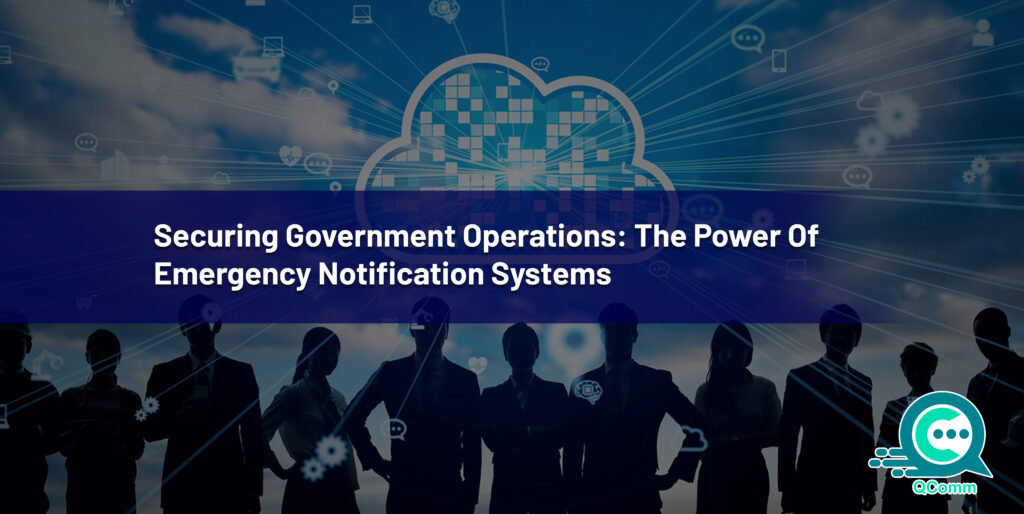
Table Of Contents
Emergencies Are Inevitable—Effective Communication is Key for Preparedness
Emergencies are an inevitable part of organizational operations, ranging from minor disruptions like power outages to severe incidents such as ransomware attacks. Regardless of the scale, the ability to communicate effectively in these situations is crucial. Additionally, having a solid Business Continuity Management (BCM) plan in place ensures that organizations can maintain essential functions during and after an emergency, minimizing downtime and financial impact.While emergencies vary in scale and nature, one common thread runs through them all: the need for clear, effective, and timely communication.
In our previous discussions, we explored the significance of resilient communication frameworks to navigate uncertainty. In this blog, we delve deeper into the distinction between routine and crisis emergencies, showcasing how tailored communication strategies can enhance organizational preparedness and response.
At Qcomm, we understand that communication is the backbone of every successful emergency response. However, we don’t believe in a one-size-fits-all approach. This blog sheds light on the varying dynamics of emergencies and provides insights into creating communication strategies that meet the unique demands of every situation.
Understanding Routine and Crisis Emergencies
Not All Emergencies Are Created Equal. Broadly speaking, emergencies can be categorized into two types: routine emergencies and crisis emergencies. Each type demands a different approach in terms of preparation, communication, and resolution. Let’s take a closer look at what sets them apart
Routine Emergencies: Everyday Operational Challenges
Routine emergencies are localized, predictable incidents that arise during normal operations. While they might seem minor at first glance, their impact can grow if they are not managed efficiently.
Examples of Routine Emergencies
- A minor electrical failure affecting a single office wing.
- Temporary internet slowdowns causing IT disruptions.
- A non-threatening fire alarm triggering evacuation.
- A sick employee requiring medical assistance on-site.
While routine emergencies don’t make headlines, they are still crucial to manage effectively. Timely communication plays a vital role here. Clear alerts, predefined escalation paths, and actionable instructions help organizations mitigate disruptions, ensuring a swift return to normalcy.
Crisis Emergencies: When Stakes Are Higher
In contrast, crisis emergencies are rare, large-scale events that have the potential to disrupt entire organizations. They often demand immediate action and dynamic communication to minimize damage and ensure safety.
Examples of Crisis Emergencies
- A ransomware attack compromising critical business systems.
- Natural disasters like hurricanes or earthquakes impacting operations.
- Global pandemics disrupting workforce availability and supply chains.
- Active threats, such as a workplace shooting or bomb threat.
Crisis emergencies are not only about managing the immediate threat—they also require organizations to think on their feet and communicate dynamically. Failure to do so can compound the damage, further delaying recovery and eroding trust among employees, stakeholders, and customers.
Bridging the Gap Between Routine and Crisis Emergencies
While routine and crisis emergencies differ in scale, they both emphasize the need for a robust communication framework. Organizations should aim for a unified strategy that can easily adapt to emergencies of any magnitude.
Routine Emergencies: Simplifying the Process
Routine emergencies may seem minor, but their cumulative effect on productivity and morale can’t be overlooked. The goal in these situations is to ensure quick resolution with minimal disruption—something that can only be achieved with a well-organized communication system.
In such cases, communication doesn’t need to be complex. It needs to be timely, precise, and efficient. For instance, a minor power outage or a network slowdown requires concise alerts sent to affected individuals, paired with predefined escalation procedures. This prevents unnecessary panic while ensuring resolution steps are underway.
Key elements of handling routine emergencies effectively include:
- Predefined Protocols: Clear steps that guide the team on who to notify, what actions to take, and how to prevent escalation.
- Localized Communication: Only those directly impacted are informed, avoiding unnecessary interruptions for others.
- Automation: Automated notifications for frequent incidents like maintenance schedules or minor disruptions save time and resources.
By keeping the communication straightforward yet actionable, organizations can resolve these everyday hurdles efficiently, ensuring operations stay on track without overburdening management or employees.
Crisis Emergencies: Elevating the Response
Crisis emergencies demand a completely different approach. When the stakes are high, communication needs to be more than efficient—it must be strategic, adaptive, and responsive.
Whether it’s a natural disaster, a cybersecurity breach, or an active threat, clear communication is often the difference between chaos and order. A crisis is not the time for guesswork, it’s the time for precision, agility, and leadership.
Effective communication in crises is defined by:
- Real-Time Updates: Information must flow rapidly to ensure all stakeholders are informed and ready to act.
- Multi-Channel Delivery: Reaching employees through SMS, emails, calls, and push notifications ensures no one is left out, even in the most challenging conditions.
- Focused on Safety and Accountability: Prioritizing employee safety, ensuring that management knows who is safe and who may need assistance.
During crises, the communication framework must evolve alongside the situation, maintaining clarity while addressing uncertainty. By combining real-time tools with pre-prepared crisis plans, organizations can ensure swift, decisive action.
Bringing It All Together
Routine and crisis emergencies may differ in scope, but they share one unshakable truth: communication is the backbone of effective response. The way an organization communicates during these moments reflects its preparedness, adaptability, and commitment to its people.
By simplifying processes for routine issues and elevating strategies for high-stakes crises, organizations can create a communication framework that is both flexible and resilient. This is the cornerstone of a proactive emergency response—one that ensures continuity and builds trust, no matter the scale of the challenge.
Emergency and Crisis Communication Plan: A Structured Approach
The emergency and crisis communication plan outlines a strategic framework for handling both routine and high-stakes situations. This plan includes clear objectives, defined roles, communication protocols, and predetermined emergency procedures to ensure an organized, effective response. By incorporating real-time tracking, escalation paths, and regular testing, organizations can stay prepared for any emergency, minimizing disruption and protecting their people and assets.
Building a Culture of Preparedness: Empowering Your Teams
Creating a culture of preparedness is the cornerstone of effective emergency management. Technology and plans can only go so far without a team that is equipped, confident, and ready to respond. By focusing on training, communication, and empowerment, organizations can strengthen their emergency response at its core—their people.
Key Steps to Build Preparedness:
- Regular Training & Drills: Conduct hands-on simulations to ensure employees are familiar with emergency procedures and can act swiftly under pressure.
- Proactive Reporting Culture: Encourage employees to report incidents or risks early without fear of repercussions, fostering transparency and quick action.
- Decentralized Decision-Making: Empower team leads and key individuals with the authority to make decisions during emergencies, reducing bottlenecks.
- Consistent Feedback Loops: After any emergency or drill, gather input from teams to identify gaps and refine protocols.
- Psychological Readiness: Provide resources and support to help employees stay calm and focused during emergencies, ensuring clarity in communication and actions.
By integrating these steps into daily operations, organizations can ensure their teams are not just responders but proactive problem-solvers, ready to tackle any situation with confidence.
Lessons Learned: Turning Emergencies into Opportunities for Growth
Emergencies are not just tests of resilience; they are opportunities for organizations to evolve and improve. Once the immediate threat is resolved, it’s crucial to reflect on the experience and extract lessons that can enhance future preparedness. A structured post-emergency analysis helps turn challenges into actionable insights, fostering a culture of continuous improvement.
How to Learn and Grow from Emergencies
- Conduct Post-Emergency Reviews: Organize debriefing sessions with key stakeholders to evaluate the response. Identify what worked well, what caused delays, and areas needing improvement.
- Gather Team Feedback: Employees on the ground often have the most practical insights. Encourage them to share their experiences to uncover blind spots in processes or communication.
- Refine Emergency Plans: Use the findings to update your protocols, ensuring they are more robust and tailored to real-world scenarios.
- Enhance Communication Channels: Analyze the effectiveness of your communication tools. Were messages delivered quickly and clearly? If not, adjust the methods or channels used.
- Celebrate Successes: Recognize and reward teams for their efforts, reinforcing trust and motivation. Highlighting wins boosts morale and sets a positive tone for future challenges.
Every emergency offers an opportunity to build a stronger, more resilient organization. By turning critical moments into growth milestones, businesses can not only safeguard their operations but also foster a sense of confidence and unity among their teams.
The Role of Leadership in Emergency Preparedness
Effective leadership is the cornerstone of managing both routine and crisis emergencies. A leader’s actions during critical moments can shape the outcome and set the tone for the entire organization.
Key Leadership Strategies for Emergencies:
- Foster a Culture of Readiness: Build preparedness into the daily fabric of the organization.
- Decisive Action: Make timely, confident decisions under pressure.
- Clear Communication: Provide transparent, empathetic updates to all stakeholders.
- Delegate and Trust: Empower teams by clearly defining roles and trusting their expertise.
- Support After the Storm: Lead recovery efforts and ensure the well-being of the team.
Leaders are not just decision-makers—they are the calm in the storm, guiding their teams with clarity and confidence, ensuring both immediate response and long-term resilience.
Building Organizational Resilience Beyond Emergencies
Emergency preparedness is just one piece of the puzzle. To truly thrive in the face of uncertainty, organizations must build resilience that goes beyond just responding to crises. Resilience is about fostering a mindset and systems that enable an organization to adapt, recover, and grow stronger after every challenge. At Qcomm, we understand that having the right technology at your fingertips is crucial for maintaining a strong, prepared workforce in times of crisis.
With this, organizations can seamlessly integrate their emergency plans, ensuring quick responses and efficient communication across all levels. Real-time notifications, automated workflows, and centralized command centers are just some of the features that help businesses stay connected and prepared for anything. By utilizing technology, teams can not only respond faster but also learn and adapt from each experience, improving their preparedness for future events.
Building resilience is an ongoing effort. It’s about cultivating a culture where everyone—leaders, teams, and individuals—understand their role in maintaining continuity and strengthening the organization. This proactive mindset prepares organizations not just to survive, but to thrive, regardless of the challenges they may face.
Preparing for the Future—A Continuous Commitment
As organizations grow and face evolving challenges, emergency plans should be revisited and refined at least once a year to ensure continued effectiveness. At Qcomm, we understand that preparedness is dynamic, which is why our solutions are designed to adapt as your organization changes.
Long-term success in emergency preparedness comes from fostering a culture of continuous improvement. This involves not only regular drills and updated communication protocols but also integrating emerging technologies to stay ahead of potential risks. With Qcomm’s scalable tools, organizations can maintain a proactive, flexible approach, ensuring they’re always ready, no matter what the future holds.
The key to resilience is preparedness that never stops evolving. By staying proactive, reviewing strategies, and embracing innovation, organizations can ensure they’re equipped for whatever comes next.
In conclusion, the real strength of an organization lies in its ability to respond to emergencies with confidence and clarity. By tailoring communication strategies, leveraging technology, and prioritizing leadership, businesses can not only survive disruptions but thrive in the face of adversity.
Ready to enhance your emergency response? Explore more about how Qcomm’s emergency solutions can help your organization stay prepared, connected, and resilient through every challenge.


